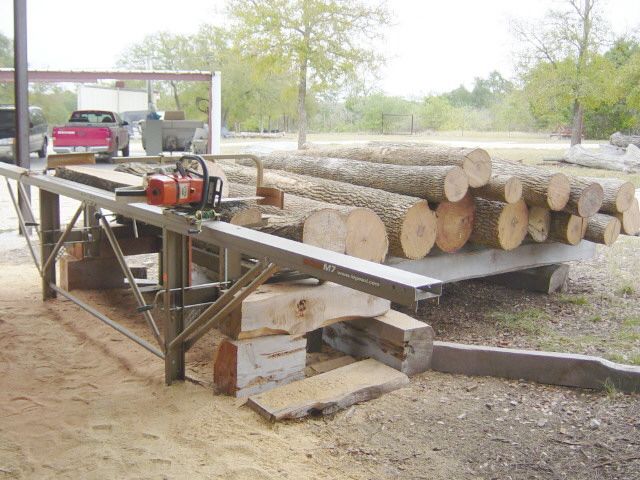Question
I'm a new mill user. I've cut a bunch of softwood, but am making my first venture into sawing cherry. What are some tips on cutting cherry? These logs are 8 ft. long and approximately 24" wide, very straight. The customer I'm sawing them for is going to edge them and he wants 1" and 2" lumber. How can I yield the most good boards? Any help would be appreciated!
Forum Responses
(Sawing and Drying Forum)
From contributor G:
Add that 1/8 inch to your cuttings. I don't cut, I make, and would love true 2 in and not 1 7/8. Find your potential customers first and cut custom for their needs.
Forest Products Society Catalog
Square up your cant and saw for grade, turning whenever necessary to find the best face, but do not saw through the pith. It'll cause problems down the road. I'd even go so far as to use a sharpie on the end and draw the box that you want, and measure the rest of the cant to decide what I was going to saw out of it.
Incidentally, 2-inch lumber, called 8/4, is usually sawn 2-1/8 inch thick or even a bit thicker. It is only when 8/4 lumber is dried and planed that it would be 1-7/8. As you already have your customer, you should ask him for the green size that he wants. Recognize that the thicker you cut it, the lower the grade will be. Further, 8/4 No.2 Common cherry has very low prices, as nobody wants this item.
Regarding cupping, it is best controlled in drying. Cherry is not known for cupping when drying is done correctly.
I agree with contributor R and I would not cut 16/4 (or a 4x4) out of the heart, as this is very hard to dry and may miss some nice pieces of lumber. Instead, cut 4/4 or 5/4. Low grade cherry still has good values. Overall, 4/4 cherry is a premium product. Do not worry about using 5/4 for table tops; most manufacturers use 4/4.
As the best part of a log is on the outside, cut thinner lumber (4/4) from the outside for sure, unless your customer wants all of it thicker. For lower quality logs of cherry (I believe that is what is meant by the term "crap logs" in one posting; but you did not mention that you had such logs), still grade saw them as you will still recover some upper grade pieces. After drying, lower grade pieces can be remanufactured into clear small pieces.
For the future, it would be better if the logs were 10 or 12' long, as longer lumber has many advantages in processing and value.
As far as sawing through the pith on cherry, it isn't any harder on the saw. It is usually just juvenile wood and soft, checked, rotten sometimes, etc. I've heard of most people boxing the heart to avoid this, but some do not.
Doc, I am young, so sometimes I question things written 50 years ago. Would you say that the writings in that forestry book are still the norm today? Have things changed with time and technology?
Regarding sawing, you do not flip after one cut. Let's say you start on the best face and saw with full taper. Then you continue sawing on that face until the adjacent faces promise higher grade (in the sawyer's opinion). Then flip 180 and saw a piece of lumber. If this piece is low in grade or the next piece will be low in grade, while the adjacent pieces promise higher grade, then it is time to turn the log 90 or 270 degrees. This is the standard rule for turning a log. Again, read the book, etc. In practice, the sawyer may delay turning in order to obtain a certain smaller size cant that might be needed for a resaw, or other reason.)
The lower grade portion of a log is on the inside, generally, so the deeper you cut, the lower the grade of lumber. If cutting 4/4, you might get an FAS-1 face piece on the outside and then a No.2 piece next. If you cut 8/4 instead, you would get a No.2 Common piece, as that is the grade of the inside face. Remember that hardwoods are graded from the worst face.
Regarding the question asked, you would continue cutting the log entirely into lumber, rotating according to the rule mentioned. You would not make a 4x4 cherry cant or other size as there is really no market for low grade of such size. Saw the entire log into lumber.
Regarding lumber size, if he wants 7/8" or even 15/16", then cut 4/4, which is actually 1-1/16" or a bit thicker. Do not cut 5/4 (1.25 or so) to get 7/8" finished.
Note to contributor T: Technically speaking, the rules are that 5/4 must be 1.25" minimum thickness green and also when air-dried. When kiln-dried, the thinnest allowed is 1/16" under 1.25", or 1-3/16". This is the minimum and so most pieces will be a bit thicker rather than having all pieces right at the minimum.
I am not clear on what the discussion is about when saying that you add the thickness of the blade to the size of the lumber. Perhaps he means that when sawing 4/4 (actual size 1-1/16") that you do not move the log or cant 1-1/16" and take the next cut, but you move the log 1-1/16 plus the thickness of the blade, so that the lumber will be 1-1/16 as you require. (Some saws move the saw and not the log; so just change the wording if this is the case for you.)
